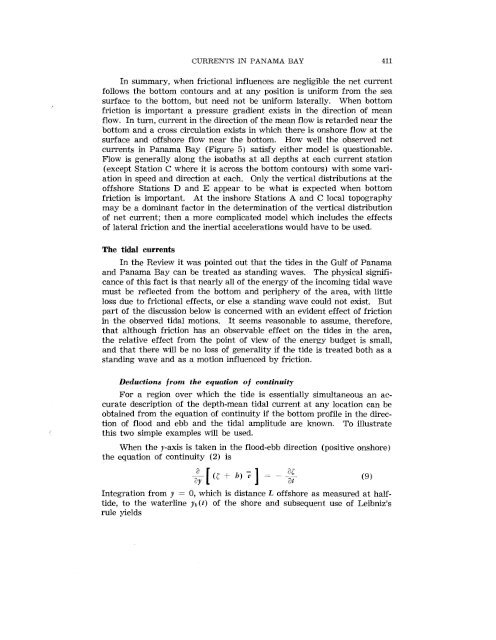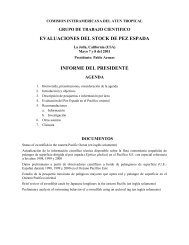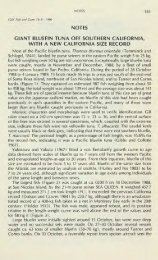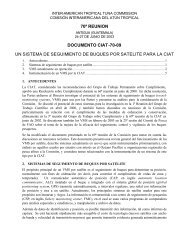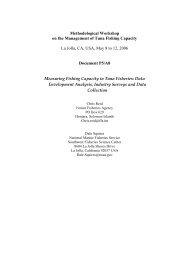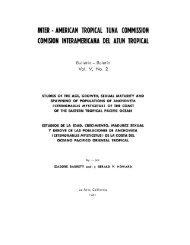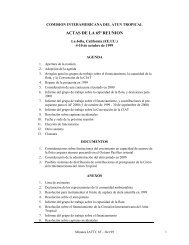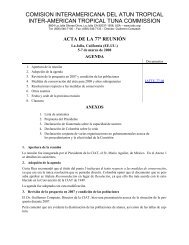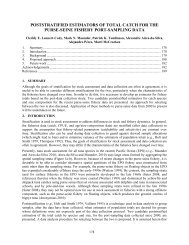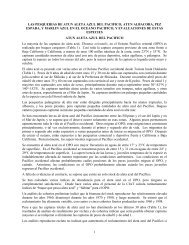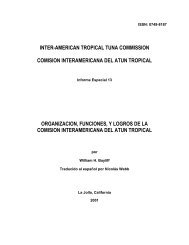t - Comisión Interamericana del Atún Tropical
t - Comisión Interamericana del Atún Tropical
t - Comisión Interamericana del Atún Tropical
- No tags were found...
Create successful ePaper yourself
Turn your PDF publications into a flip-book with our unique Google optimized e-Paper software.
CURRENTS IN P ANAMA BAY411In summary, when frictional influences are negligible the net currentfollows the bottom contours and at any position is Lmiform from the seasurface to the bottom, but need not be uniform laterally. When bottomfriction is important a pressure gradient exists in the direction of meanflow. In turn, current in the direction of the mean flow is retarded near thebottom and a cross circulation exists in which there is onshore flow at thesurface and offshore flow near the bottom.How well the observed netcurrents in Panama Bay (Figure 5) satisfy either mo<strong>del</strong> is questionable.Flow is generally along the isobaths at all depths at each current station(except Station e where it is across the bottom contours) with sorne vari-.ation in speed and direction at each. Only the vertical distributions at theoffshore Stations D and E appear to be what is expected when bottomfriction is importante At the inshore Stations A and e local topograp,hymay be a dominant factor in the determination of the vertical distributionof net current; then a more complicated mo<strong>del</strong> which includes the effectsof lateral friction and the inertial accelerations would have to be used.The tidal currentsIn the Review it was pointed out that the tides in the Gulf of Panamaand Panama Bay can be treated as standing waves. T'he physical significanceof this fact is that nearly all of the energy of the incoming tidal wavemust be reflected from the bottom and periphery of the area, with littleloss due to frictional effects, or else a standing wave could not existo Butpart of the discussion below is concerned with an evident effect of frictionin the observed tidal motions. 1t seems reasonable to assume, therefore,that although friction has an observable effect on the tides in the area,the relative' effect from the point of view of the energy budget is small,and that there will be no loss of generality if the tide is treated both as astanding wave and as a motion influenced by friction.Deduetions from the equu,tion of eontinuityFor a region over which the tide is essentially simultaneous an accuratedescription of the depth-mean tidal current at any location can beobtained from the e'quation of continuity if the bottom profile in the directionof flood and ebb and the tidal amplitude are known. To illustratethis two simple examples will be used.When the y-axis is taken in the flood-ebb direction (positive onshore)the equation of continuity (2) is_o[(t + h) v] == - ~(9)ay - alIntegration from y == 0, which is distance L offshore as measured at halftide,to the waterline Yb (1) of the shore and subsequent use of Leibniz'srule yields


